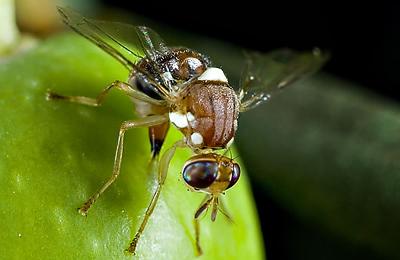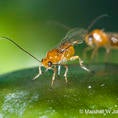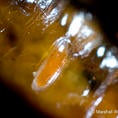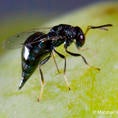Olive Fruit Fly, Bactrocera oleae(Rossi) (Diptera: Tephritidae)
The Situation: Olive fruit fly is the major insect pest of olive crops worldwide. It is in the insect family Tephritidae that contains many well know pests species such as the Mediterranean fruit fly. It has impacted olive production since biblical times. In some parts of the world, olive fruit fly is responsible for losses up to 80% of oil value and 100% of various cultivars used as table olives. This species lays its eggs in all sizes of fruit, but prefers large green fruit. Eggs are laid underneath the fruit epidermis and hatch in a few days in warm weather. The resulting maggot feeds on the fruit pulp and it passes through three larval instars and then pupates either within the fruit during early and mid-summer or on the ground in late summer and fall. This insect only reproduces on olive fruit, but the adults may feed on a number of substances found in nature including insect-produced honeydew, bird excrement, plant pollen, fruit exudates, and bacteria and yeast found in its environment.
California produces > 99% of the olives grown in the USA. Olives destined for table consumption are mostly grown in the Central Valley Counties of Tulare, Fresno, Madera, Glenn, Tehama, and Butte. These are mainly processed as California black olives that are commonly eaten on pizzas, in salads, and on sandwiches. Olives produced for their oil content are mostly grown along the Central Coast and the Central Valley. Although olive fruit fly has been a pest in the Mediterranean and Middle East regions over the last century, management techniques used in those locations were unsuitable for California because these programs use restricted compounds such as dimethoate and fenthion (organophosphate insecticides) and also have the support of government-assisted, area-wide management programs for the pest.
Damage: Olive fruit fly impacts olive production in three ways and the amount of damage it causes varies with the intended purpose of the olive fruit. Indentations left by the ovipositor (egg-laying organ) of the olive fruit fly may leave unwanted marks on the fruit, which may be considered as cosmetic damage. Small fruit (~ 0.2 to 0.5 inches in diameter) that are probed by the olive fruit fly’s ovipositor may abort and fall from the tree thereby reducing total fruit yield. Maggots feeding within the olive will destroy its value as a table olive because these fruit may break apart during the curing process. Furthermore, due to worries over consumer acceptance, almost zero maggot infestation is acceptable in olive fruit harvests destined for human consumption. Because of this, table olive growers commonly apply weekly insecticide treatments for olive fruit fly control. Olives that will be pressed for their oil may have from 10 to 30 percent olive fruit fly infestation without a problem unless fruit pressing is delayed following harvest. Damaged fruit that are stored for longer than a few days may have increased levels of acid within them that will alter the flavor of their oil. There is a direct correlation between acid accumulation and the build-up of microorganisms [e.g., bacteria (Xanthomonas), yeasts (mostly Torulopsis and Candida), and molds (mainly Fusarium and Penicillium)] that develop in damaged fruit. The percent infestation by olive fruit fly maggots is not indicative of the amount of flavor change due to microorganisms.
Economic Impact: Prior to the establishment of olive fruit fly in California, table olive growers in the major production areas (i.e., Central Valley) only had two insect pests to worry about. These were the black scale, Saissetia oleae (Olivier), and olive scale, Parlatoria oleae (Colv´ee). The former is controlled by a combination of biological control and pruning of olive trees to increase airflow within the leaf canopy when temperatures rise in the summer. The latter species is controlled by natural enemies introduced in a classical biological control program. With the appearance of the olive fruit fly in mid-June, table olive growers typically initiate treatments of an insecticidal bait formulation marketed as GF-120 NF Naturalyte Fruit Fly Bait (produced by Dow AgroSciences LLC) that contains a highly effective fruit fly attractant and a small portion of the insecticide spinosad®. Treatments are made on a bi-weekly schedule until the olives are harvested in September through November. The average olive acreage per California grower is 30 acres. The “average table olive grower” would pay between $1,920 and $3,456 in treatment costs (materials & labor) for 30 acres depending on if the individual harvested early in mid-September (10 sprays) or late in mid-November (18 sprays), respectively. Oil producers could potentially pay more because the fruit is harvested later to increase oil content, but they have a higher acceptable damage threshold. Thus, the presence of the olive fruit fly has dramatically increased production costs for California olive growers.
Distribution: The olive fruit fly probably evolved in southern Africa and then followed the path of olive cultivation into the Middle East and southern Europe. In 1998, the fly was first discovered in the Los Angeles area and was found to be distributed from Santa Barbara to San Diego shortly thereafter. Molecular analysis suggests that the fly was introduced from the Mediterranean region. By 2002, the fly was found in most areas throughout California where olives can be grown, which covers most of the coastal areas and much of the Central Valley. Fruit-producing olive trees are grown for commercial production purposes and as ornamental trees throughout much of California. This means that in some areas, ornamental olives may serve as an untreated reservoir for olive fruit fly populations that may disperse to commercial olive plantings.
Research: Numerous researchers representing a variety of institutions (UC Riverside, Davis, and Berkeley, California State University – East Bay) and agencies (CDFA, USDA Agricultural Research Service) have worked on various aspects of olive fruit fly biology, ecology, and management in California. Although GF-120 insecticidal bait treatments maintain the olive fruit fly at sub-economic levels in most areas, researchers are trying to identify weak points in the fly’s biology that can be exploited for management purposes so that the reliance on GF-120 can be reduced. This is important because of the high costs for control experienced by olive producers as well as the potential for olive fruit fly to evolve resistance to the spinosad® insecticide in the bait product. Investigators have examined various types of traps used for monitoring olive fruit fly populations and management (i.e., attract & kill traps); the use of particle film to alter the attractiveness of olives to female flies; the susceptibility of various olive cultivars to infestation; the impact of summer temperatures on fly behavior and mortality; and the introduction of exotic natural enemies for biological control. In the Central Valley, it was found that high summer temperatures (≥ 100ºF) negatively impact fly behavior and survival, which leads to reduced infestations during parts of July and August. Following host testing and risk assessment, two exotic parasitoids, Psyttalia concolor (Szépligeti) and Psyttalia lounsburyi (Silvestri), were approved for release and work is underway to establish and evaluate the effectiveness of these species in olive production areas. Efforts continue to introduce additional natural enemies so that olive fruit fly can be managed in the diverse climatic regions in which it occurs.
More Photos of Olive Fruit Fly | Provided by Marshall Johnson
Center for Invasive Species Research, University of California Riverside
Text and photos provided by: Marshall Johnson
Marshall Johnson, Extension Specialist , Entomologist & Lecturer
marshall.johnson@ucr.edu








